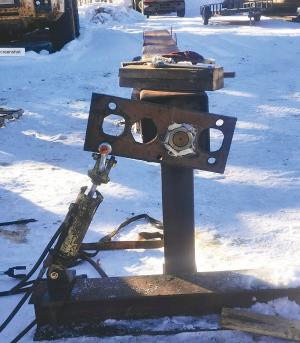2023 - Volume #47, Issue #3, Page #35
[ Sample Stories From This Issue | List of All Stories In This Issue | Print this story
| Read this issue]
Hydraulic “Wrench” Built For Big Jobs
 |
“I built it for breaking 4 to 5-in. nuts on large hydraulic cylinder rams when I needed to change the packing or rebuild a cylinder,” explains Erdman. “Those nuts take a lot of torque.”
Erdman put 8 by 8-in. sq. box steel tubing legs on either end of a 15-ft. length of 12-in. sq. box tubing. At the working end, he welded a length of 8-in. wide flange I-beam perpendicular to and centered on the leg. It serves as a stabilizing foot for the leg and as a base for the cylinder/wrench.
Erdman fabricated an insert for the 12 by 12-in. tubing to anchor the hydraulic cylinder that needed repair. It consisted of two 3/4-in. thick steel plates sized to fit inside the steel tubing with 4-in. spacing between them. They connected at one end with a large bracket. He drilled holes in the center of the other ends and welded a steel rod in place.
“When I needed to work on a cylinder, I slipped the clevis end over the rod and pinned it in place,” says Erdman. “Then I pushed the insert and cylinder into the tubing.”
The head of the hydraulic wrench is a 12 by 36-in., 1-in. thick steel plate. Erdman drilled holes in all four corners of the plate and cut out a hole the size of the nut to be turned.
“I cut out a piece of cereal box the size of the nut and used it as a template to cut a hole in the 1-in. steel plate,” says Erdman. “Over time, I cut multiple holes out of the plate to match different nut sizes.”
To crack the nut, Erdman would slip the plate with the hole over the nut. Once he pinned the cylinder/wrench ram through a corner hole in the plate, he could activate the cylinder. As the ram extended, the plate turned, turning the nut as it did. When the large cylinder repair was finished, Erdman simply reversed the process to retighten the nut.
“I always marked the ramrod and the nut to bring it back to the right torque when reassembling,” says Erdman.
Contact: FARM SHOW Followup, Dan Erdman, Box 1620, Claresholm, Alta., Canada T0L 0T0 (ph 403-382-1020; derdman2@telusplanet.net).

Click here to download page story appeared in.

Click here to read entire issue
To read the rest of this story, download this issue below or click here to register with your account number.




